- Joined
- Jul 27, 2009
- Messages
- 4,119
Probably a case of someone running their social media taking liberties with the actual messaging around the GIA cut research. It seems everyone is susceptible to engaging in hyperbole!
Great article John. But note that the green is almost totally absent in all your real life photos. You might need to explain that.
http://www.gemology.ru/cut/english/rainbow/3.htmIs there a reason why?
Thanks everyone! Lots of very interesting posts
Is there a reason why?
Thanks everyone! Lots of very interesting posts
In terms of conversation and definitions, I'd add this:
So what you "see" isn't just about the illumination scenario and cut-geometry (or absorption spectroscopy - which is another can of gummis). It's also about your pupil constriction or dilation, your specific physiology - people see color differently - whether you're wearing glasses, etc.
- Dispersion occurs physically, within the diamond.
- Absorption (when relevant) occurs physically, within the diamond.
- "Seeing" Fire occurs physiologically, at the human eye.
I wrote an article for IGI on the topic a couple of months ago, with graphics and photos, in case it's interesting.
Linked here: Dispersion & Fire are not the same thing.
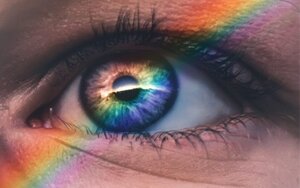
Thank you for the opportunity @Garry H (Cut Nut). And you are spot-on.Great article John. But note that the green is almost totally absent in all your real life photos. You might need to explain that.
I'm glad you enjoyed the overview @Malha777.I very much enjoyed reading the article and I was wondering if this part
“If a dispersive-fan passes over your eye and is wider than your pupil’s diameter you will see a colored flash. If a dispersive fan passes over your eye but is smaller than your pupil’s diameter the light recombines and you see a white flash. If the fan is too small or weak you see nothing. In optimal cases a single, wide dispersive-fan passing across your pupil may cause you to see a full suite of shifting chromatic colors.”
Is the reason why RBC having ideal cut with a lower half percentage of 75 have usually more fire than other with 85% that will show more white flashes instead?
Thank you for the opportunity @Garry H (Cut Nut). And you are spot-on.
In essence, green is situated between the IR (infra-red) and visible red and UV (ultra-violet) and visible violet. So it becomes the stepchild of the extremes. Rarely seen compared to visible flashes of red,yellow, blue and purple.
Here's a better look at the real-life situation via video. Thanks to the magic of "steady hands" you can see the green there, in the middle of the dispersive-fan. But, physiologically, it's indeed the most difficult to capture with your pupil.
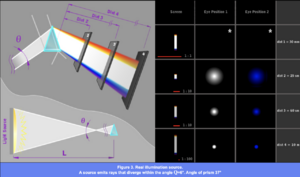
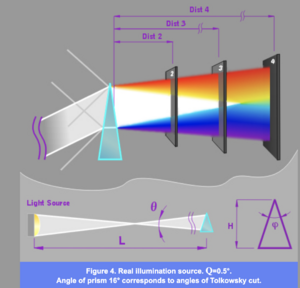
re: video clip, in the background: let the pigeon drive the bus!!!

Hi Sergey. First, thank you for reading the article.John,
re:Shallow or Deep geometries cause light to exit through the pavilion, suppressing brightness and dispersion.
I would like to know a sample of "Shallow" proportions that creates leakage considerably higher than "Proportionate" diamonds.

Hi Sergey. First, thank you for reading the article.
Second, you raise a good point of order. We know brightness suppression in shallow sets is due to obstruction through tilt, and potential girdle-reflection. We know traditional light-path diagrams seen in teachings and stores are folly. Garry has crusaded about that for years.
The challenge is the KISS principal: In live classes I can explain how those traditional models are wrong. I've done it many times. On average, 20% of the jewelers in the room are with me and super-excited to get the information. But 60% struggle with the idea that the diagrams posted in every store in the USA are wrong, and the other 20% just want the techno-babble to be over.
It's a matter of choosing a battle: For the article in question the goal is illustrating that dispersion occurs physically, within the diamond, whereas perception of fire occurs physiologically, at the human eye.
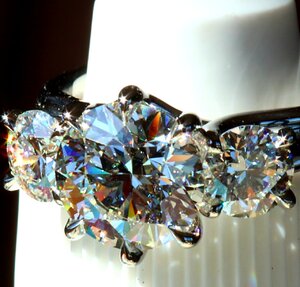
Sergey,John, I believe, working KISS solutions can not be established on Wrong statements. When you use wrong statements you just simplify your job but you do not achieve real KISS solution.
Sergey,
Truth. I already agreed and made the edit. Thanks for the perspective.
Larger questions -
- Have you image-Googled "diamond cut diagram shallow deep" ?
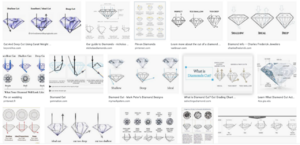
Sergey,
- If so, what are you doing to address this at a more meaningful level?
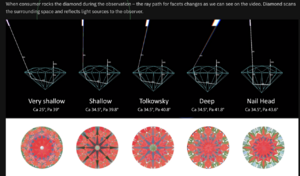
Showing my mom side....lol!!
Thank you for the opportunity @Garry H (Cut Nut). And you are spot-on.
In essence, green is situated between the IR (infra-red) and visible red and UV (ultra-violet) and visible violet. So it becomes the stepchild of the extremes. Rarely seen compared to visible flashes of red,yellow, blue and purple.
Here's a better look at the real-life situation via video. Thanks to the magic of "steady hands" you can see the green there, in the middle of the dispersive-fan. But, physiologically, it's indeed the most difficult to capture with your pupil.
Here is a video explaining my frustration
Sergey the first one that is correct has 2 diamonds that do not exist. The others are stolen from me and used online. What is used instores are never that complex.In first 15th images I see 3 with correct ray tracing. So now 20% such diagrams are not completely wrong that is much better result than several years ago. Unfortunately even these 20% have unreal proportions for shallow and steep diamonds because the real goal was is to create scare instead to give education , knowledge .
Until now most companies push consumers to buy "Ideal cut" then by using unreal "diamond cut diagrams steep-shallow". Scare marketing is very destructive approach for diamond business

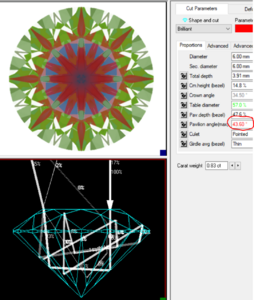
LOLGarry, It is not an error, it is KISS.
20% sounds right. You're seeing a reflection of what I told you above. 20% are willing to adapt - even if they don't "get it" quite correctly. 60% resist changing their erroneous KISS diagrams and 20% don't want to discuss the topic.In first 15th images I see 3 with correct ray tracing. So now 20% such diagrams are not completely wrong that is much better result than several years ago. Unfortunately, even these 20% have unreal proportions for shallow and steep diamonds because the real goal was is to create scare instead to give education , knowledge
It's why I prefer using the word 'proportionate' in my training materials.Until now most companies push consumers to buy "Ideal cut" then by using unreal "diamond cut diagrams steep-shallow". Scare marketing is very destructive approach for diamond business
I was there for your oral and poster in 2006, with enthusiasm (was it really 14 years ago?). All of those materials are a great resource for those of us who know how to find them. But how are you reaching others?
That's a useful page. Following the 20-60-20 rule I believe many pros would be interested, if they were exposed to it. RE average consumers (away from PS), it's a lot to swallow, but I can see ways to frame the material in smaller bites. We have a saying in education: Small bites keep the students hungry.and also we are developing work shop about diamond beauty here. You can see small part that we are doing to save diamond business. I hope we are not scare consumers
In terms of conversation and definitions, I'd add this:
So what you "see" isn't just about the illumination scenario and cut-geometry (or absorption spectroscopy - which is another can of gummis). It's also about your pupil constriction or dilation, your specific physiology - people see color differently - whether you're wearing glasses, etc.
- Dispersion occurs physically, within the diamond.
- Absorption (when relevant) occurs physically, within the diamond.
- "Seeing" Fire occurs physiologically, at the human eye.
I wrote an article for IGI on the topic a couple of months ago, with graphics and photos, in case it's interesting.
Linked here: Dispersion & Fire are not the same thing.
